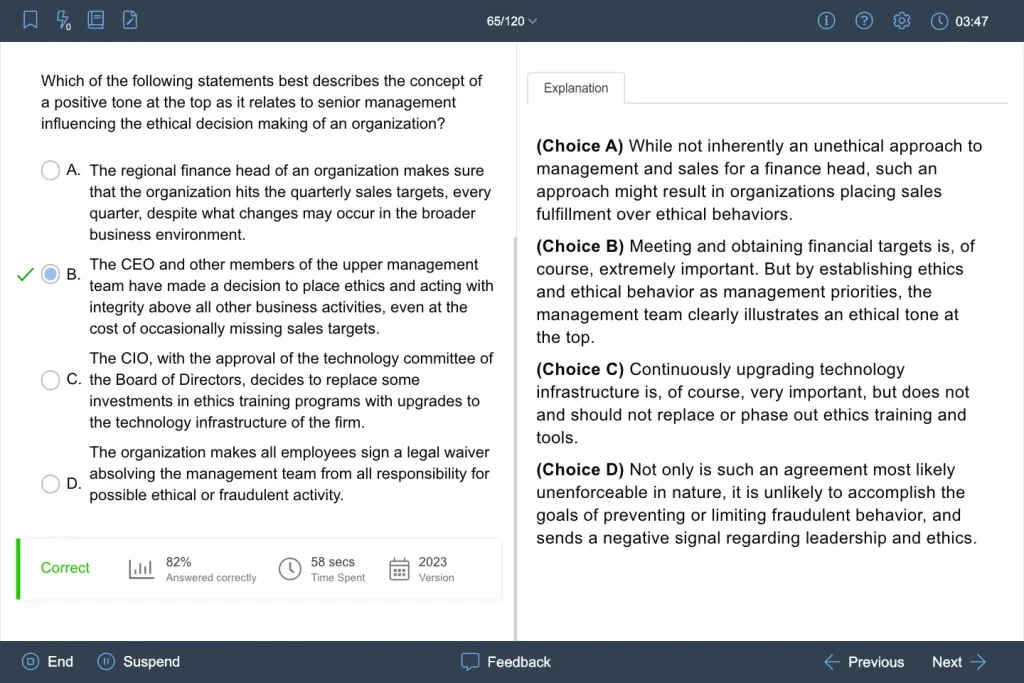
Familiarizing yourself with CMA question types for both exam parts will help you grow your confidence, boost your CMA knowledge, and maximize your performance on exam day. Try our sample questions now and discover the UWorld difference for yourself.

Our practice questions are designed to help you understand the why behind each answer choice for every question, and are written by our team of practicing CMAs. We show you detailed answer explanations for every option—no matter if you select correctly or incorrectly—to build your reading comprehension and application skills.
Get started below with our strategically-selected multiple-choice samples.
CMA Part 1 Sample Questions CMA Part 2 Sample Questions CMA Part 1 Sample QuestionsThe CMA Part 1 exam includes 100 multiple-choice questions and two 30-minute essays. See if you can answer these free questions now.
At the end of Year 3, the managers of Guardian Company are planning for Year 4. In Year 3, manufacturing overhead was $349,600, direct labor hours equaled 16,000 hours, and machine hours totaled 48,000 hours. For Year 4, manufacturing overhead is estimated to be $524,400, direct labor hours are estimated at 20,000 hours, and machine hours are estimated at 50,000 hours. If overhead is applied based on direct labor hours, what is the predetermined overhead rate for Year 4 (if necessary, round your answer to two decimal places)?
| A. | $10.49 per direct labor hour. |
| B. | $32.78 per direct labor hour. |
| C. | $21.85 per direct labor hour. |
| D. | $26.22 per direct labor hour. |
(Choice A) Incorrect. This amount is Year 4 estimated overhead divided by Year 4 estimated machine hours. Because overhead is applied based on direct labor hours, do not divide by machine hours to calculate the predetermined overhead rate.
(Choice B) Incorrect. This amount is Year 4 estimated overhead divided by Year 3 direct labor hours. When calculating the Year 4 predetermined overhead rate, use estimates from Year 4.
(Choice C) Incorrect. This amount is Year 3 estimated overhead divided by Year 3 direct labor hours. When calculating the Year 4 predetermined overhead rate, use estimates from Year 4.
(Choice D) Correct. The predetermined overhead rate based on direct labor hours for Year 4 equals the estimated overhead for Year 4 divided by the estimated direct labor hours for Year 4. The predetermined overhead rate equals $26.22 per direct labor hour ($524,400 ÷ 20,000 direct labor hours).
Which of the following emerging technologies can help in improving the efficiency of manufacturing plant assembly operations and warehouse operations?
| A. | 3D printing |
| B. | Robots |
| C. | Virtual reality |
| D. | Internet of Things |
(Choice A) Incorrect. 3D printing technology is useful in improving the efficiency and accuracy of product design whether it is a manufacturing product (e.g., an automobile or a vacuum cleaner), clothes, or shoes.
(Choice B) Correct. Robotic technology or robotic process automation (RPA) improves the speed and accuracy of assembling various parts or components in a manufacturing plant, soldering and painting subassemblies and final assemblies of parts, and other labor-intensive tasks. Similarly, robots operate in a warehouse and distribution center to locate the desired product on a warehouse shelf, to place the product in a shipping container, and to get ready for shipping to a customer so the customer order is fulfilled. The overall benefits of RPA include reduced labor costs due to less time to complete tasks, increased speed and accuracy, improved worker productivity (i.e., doing more tasks in less time), reduced human errors from not shipping wrong products to customers, and increased customer satisfaction with faster and more accurate order fulfillment process.
(Choice C) Incorrect. Virtual reality (VR) technology is a leading-edge technology applied to retail business that replicates or simulates the real world through images (goggles) and sounds that can be heard from speakers and headphones (headsets). It creates 3D graphic models to interact with images. A user of the VR equipment is immersed in a real lifelike experience while interacting with computer-simulated environment. VR technology started in video games, pilot training, and motion pictures. The VR technology has entered into medical training, military training, and other kinds of training. The goal of retailers with VR technology is to turn viewers (shoppers) into buyers (customers).
(Choice D) Incorrect. The Internet of Things (IoT) technology is a collection of several diverse and disparate technologies aimed at providing efficiency gains to a business and convenience and comfort to consumers’ day-to-day life at home. Within a business environment, the IoT means connecting or networking several systems and devices and passing data between them to operate as one seamless and cohesive system, providing insights, and requiring management decisions and actions.
All of the following statements concerning currently attainable standards are correct except: